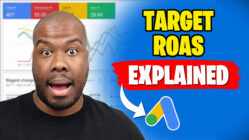Transcript – Don’t Miss These Performance Max Updates!
Google recently held a conference all about Performance Max. Yes, the whole conference was literally about Performance Max. This was a conference for the European region, the EMEA region, for Google internationally, and it was a really interesting conference because there were some things that were shared that kind of show you the direction of travel Google is taking with this product.
And the first thing that really stuck out to me was when speaker Matt Del Rey spoke about where Performance Max is now and where it’s going. Take a listen to this because I think this gives us an indication of what’s coming next.
What if we actually delivered the most full expression of AI that we’ve ever offered to the market?
Something that delivers the best performance across all of Google’s inventory. From a single campaign. We set this as the North Star vision for this product. We’re on the journey to delivering it. We’re not all the way there, but we’re part of the way there. People have this preconceived notion that as AI evolves, there’ll be fewer inputs.
I think the right way to think about this, there’ll be different inputs. Modern inputs related to what works best for ai. This we believe is the best possible advice for how to get the most from Google Ads search. Traditional search campaigns are still highly important to invest in and optimize. Those campaigns are used for the places where you need keywords to be most effective.
We think broad match is the best way to do that using ai. Obviously paired with automated bidding. Conversions and spaces where keywords are a requirement, right? And then we go to PMAX and we say there’s places across search and YouTube and all of the other consumer properties where you don’t need keywords and PMAX is the best way to get the most out of those spaces.
We’ll call them keyword lists. Right, and so when you put these two things together, you get the best possible coverage, the best possible performance, and we’ll keep you advised if we think this evolves, but we think this is the state we’ll be in for a while. We think this is really how you’ll get the best performance out of Google.
So first of all, he mentioned that this product is going to be the North Star product for Google ads, and it makes sense. This is going to be in the long term, Google’s most important product is going to be the campaign that most. Ad dollars are going to go through at the moment. Most people are spending on search campaigns.
But actually, people are going to start spending more on Performance Max. And as the system gets better, I expect that to continue and ramp up. But that’s not the interesting thing he said. What was interesting is that he said, as AI, when Google start leveraging the power of AI to inform and improve performance max campaigns, he mentioned that it means as people have a misconception that AI means less controls or less levers for the advertiser, but he actually changed the phrasing a little bit and just said, it will be different controls as opposed to less controls.
Yes, there will be different controls for advertisers, there will be ways to steer performance max. And one of the things they talked about was in this conference, which I’ll go on to shortly. But ultimately, We are going to get less control. This is just a fact. I like how he slightly dodged that part to say there’ll be different controls, not less controls, but ultimately, yeah, that there are less controls.
What he also mentions here is that he hasn’t forgotten about search, as you can see from the slide he shared. Search is still incredibly important to Google, and they see it as a side by side opportunity, where there’s going to be a search based side, where Performance Max will be secondary to search, when people are using keyword based searches to find what they’re looking for at the point they need it.
They still see search playing a big part in that, but Performance Max basically covers everything else. So, at this very stage, he did mention that he sees them working side by side, and in the short term, He doesn’t see any problem with kind of having this set up. But in the long term, as AI improves and Google starts getting better with Performance Max, then maybe Performance Max will just be a catch all for every single advertiser.
And Performance Max will essentially just become Google ads itself. The next speaker was Natalie Wertz, and she talked about another control because obviously the previous speaker, Matt, was talking about how to steer the AI as opposed to having more levers to control campaigns using kind of methods of steering with different controls.
What Natalie talks about is one of those controls, and that’s about bidding based on who the person is and where they are in the life cycle. of your products and services. So have a little listen to what she says when she talks about optimizing your campaign goals towards both high value customers, the people who spend the most money with your business using first party data, and also new customers.
If you want to make sure you’re focusing purely on new business, then this will be of interest as well, which is coming to Performance Max. We’re introducing customer lifecycle goals to help enable you all to reach the most profitable customers by driving acquisition and retention. and ultimately growing lifetime value powered by your first party data and value based bidding.
The new customer acquisition goal which enables you all to optimize to new customers in addition to your other goals like maximizing sales or generating high quality leads. The NCA goal is easy to set up within Google Ads in addition to optimizing just for new regular customers. This beta is opening this week.
There was also an additional goal in Natalie’s presentation that talked about re engagement, a re engagement goal to target lapsed customers who have churned and not returned to your business and haven’t transacted with you for a long time, or a simple campaign to re engage customers, to keep them informed and to keep them in the loop.
with your business. And I think both can be quite powerful goals, depending on what type of business you have. If you’re a business where people can buy from you multiple times over their life cycle, especially for e commerce businesses, this could be quite useful. Have a little listen to what she says about this campaign type.
Additionally, as you saw at GML, we also recently announced that the PMAX re engagement goal feature can help you optimize your campaigns to reach customers at every decision making point in that, in their life cycle journey. Like retention, re engagement of returned customers. We’re planning to launch the re engagement goal beta in the third quarter of this year.
When we think about PMAX exclusions, we encourage you to first keep in mind that Google already works to block ads from serving on queries related to sensitive topics like profanity or violence. So ensure you’re mindful about the exclusions you’re adding to make sure you’re not missing out on valuable conversions and limiting your reach and performance.
Another speaker, Tal ABAs talks about AI in particular and the product’s roadmap for Performance Max. And basically this entire conference was all about ai. AI is the buzzword today, not just in terms of things like chat, G P T, but Google are investing in AI for Google Ads in particular, in a very interesting way.
Have a little listen to what he’s saying here. There are two main reasons why digital advertising and Google Ads in particular. are a prime application for AI. The first is measurable outcomes. We all know that AI works really well when it has a clear objective function, which could be beating the world champion at Go, or in our case, maximizing sales, new customer acquisition, getting more qualified leads, or even better, bringing those all together with a conversion value expression.
The second reason why digital advertising, again, Google Ads, is really well positioned to take advantage of AI is the vast amounts of training data. From billions of users searching and browsing across all of Google’s properties, at different devices, times of day, with different interests. We can feed all of that data back into the AI to show the right ad to the right user and also set the right bid for each and every auction in real time so that we can maximize performance.
We have three key pillars for how we’re thinking about the roadmap in 2023 and beyond. The first is controls to steer the AI. The next pillar is ease of use and workflows. And the third is proving the value of PMAX. And we’re launching a feature called New Customer Acquisition with High Value Optimization.
It will allow you to bring your first party data into Google Ads with New Customer Acquisition. Tell us who’s most valuable for your business so that we can then go and find new customers. who are also high value like those existing high value customers. We’re adding a feature that I think we know has been, you know, widely requested.
It’s called campaign level brand exclusions. In your Performance Max campaign, you’ll be able to go in, add an exclusion for your own brand terms. This will exclude it from your Performance Max campaign, and then you can optimize those in your search campaigns through keyword targeting. And that will allow you to give a different ROI target from how you’re capturing this value in Performance Max.
We’ve launched recently account level negative keywords, which will allow you to exclude across your account keywords that you don’t find safe for your brand or you find sensitive. You’ll also have a sandbox available in the asset picker where you can go and add more inputs and try to refine the inputs and create new images that you can use in your marketing.
Feeds are another really good example of how you can give input. to the AI and tell us more about your business so that we know how to optimize on your behalf. So what was really interesting with that last thing he just said was, when you think about how you’re optimizing your campaigns and you think of automated smart bidding and obviously using broad match keywords with search, you think Google’s learning how people are interacting with your campaign and then optimizing bids accordingly, but no, That’s not what’s happening.
Google is using every single signal across all of their products and the billions of searches taking place and using that behavior to feed the AI model that Performance Max is powered by. So it’s way more powerful than you’d expect because imagine every single interaction on Google and all of Google products, including Gmail, obviously search and maps and basically anyone, anything that serves ad inventory.
Google is going to learn how people are using these products, and they’re also going to be measuring conversions. And when you’re tying the conversion together with the user behavior and feeding that language model, I suppose, on the AI side, Google are going to have tons of data to inform their bidding strategy by pooling everybody together.
So that is incredibly powerful and interesting. And this will be the future of Google ads. Ultimately, it was a good conference. I think there was some interesting new developments coming and I think we can all see the direction of travel when it comes to Google ads in the long term. If we didn’t know already.
This reinforces it. But what do you think? What are your thoughts on the future of Performance Max and Google Ads in general? Are you fearful for the future? Were you quite excited with all the new AI stuff coming out? Let me know in the comments. I’ll be more than happy to talk with you down there. I reply to pretty much every comment on all new videos.
Like this video if you like it. Don’t forget to subscribe. Check out the other content across my channel, and I’ll see you guys on the next one.







